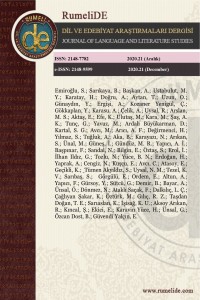Öz
1940 Toplumcu Gerçekçi Kuşağı şairlerinden biri olan Cahit (Saffet) Irgat (1915-1971), ilk şiirlerini Cahit Saffet imzasıyla 1935 yılında Varlık dergisinde yayımlar. Geleneğin etkisiyle yazdığı bu romantik şiirlerinden sonra toplumcu gerçekçiliği benimser ve tarzını değiştirir. 1940’larda Türk şiirinin iki egemen söylemi olan Garip anlayışı ve toplumcu gerçekçiliğin etkisinde kalsa da zamanla kendi sesini bulur. Diğer toplumcu gerçekçi şairlerin aksine köy ve kır hayatına değil, şehir hayatının tasvirine yönelir ve ilk şiir kitabı Bu Şehrin Çocukları’ndan (1945) itibaren şiirlerinde şehir imgesi başat bir unsur olarak karşımıza çıkar. Şehri gözlemleyerek elde ettiği görüntü ve izlenimleri şiir malzemesi hâline getirir. Aynı tavrı daha sonra yayımladığı Rüzgârlarım Konuşuyor (1947), Ortalık (1952) ve Irgat’ın Türküsü (1969) isimli şiir kitaplarında da sürdürür. Şiirlerinde umut temasını da işlemesine rağmen şehrin hayatına ve insanlarına bakışında kötümser bir tavır vardır. Özellikle II. Dünya Savaşı’nın sosyo- ekonomik koşullarını yansıttığı şiirlerinde şehri, yoksulluğun kol gezdiği bir mekân olarak ele alır. Rüzgârlarım Konuşuyor, savaş sırasında istila edilmiş şehirlere ithaf edilmiştir ve şehri savaş ortamında deneyimleyen bir şiir öznesinin duygulanımlarını içerir. Irgat, birçok şiirini savaş atmosferinin etkisinde kalarak yazar; çünkü şehre baktığında ölümü görür. Bu çalışmada, toplumun sorunlarına gerçekçi bir bakış açısıyla değinen şiirler yazan Cahit Irgat’ın eserlerinde öne çıkan şehir imgesinden hareketle şairin mekânı nasıl deneyimlediği ve şehrin dilini şiirine hangi yollarla aktardığı incelenecektir.
Anahtar Kelimeler
Kaynakça
- Altınkaynak, H. (1977). Edebiyatımızda 1940 kuşağı. İstanbul: Türkiye Yazarlar Sendikası.
- Bezirci, A. (1971). On şair on şiir. İstanbul: May. ...........................
- Cansever, T. (1996). “Şehir”, Cogito (Kent ve kültürü özel sayısı), 2, s.125-129.
- Ertuş, A. (2017). “Cahit Irgat’ın şiirlerinde savaş karşıtlığı”, Yüzüncü Yıl Üniversitesi Sosyal Bilimler Enstitüsü Dergisi, 1(2), s.123-132.
- Irgat, C. (2018). Irgatın türküsü: bütün şiirleri. Kırmızı Kedi: Ankara...........................
- Karaca, A. (2009). “Turgut Uyar’ın şiirlerinde modern kent imgesi”. Yüzüncü Yıl Üniversitesi Sosyal Bilimler Enstitüsü Dergisi, (16), s.5-27.
- Kurdakul, Ş. (1987). Çağdaş Türk edebiyatı II: Cumhuriyet dönemi (1923-1950). İstanbul: Broy.
- Lefebvre, H. (2015). Şehir hakkı. Sel: İstanbul. .......................................
- Narlı, M. (2014). Şiir ve mekân (2. Baskı). Akçağ: Ankara. ......................
- Oktay, A. (2002). Metropol ve imgelem. Türkiye İş Bankası Kültür: İstanbul.
- ……………… (1993). Cumhuriyet dönemi edebiyatı 1923-1950. Ankara: Kültür Bakanlığı
- Yıldız, A. (2017). “Necip Fazıl’ın şiirlerinde şehir imgesi”, Düşünen Şehir, s.104-114.
- Yılmaz, S. (2017). “1940’ların Türk şiirinde ‘küçük adam’ ve serüvenleri”. Yüzüncü Yıl Üniversitesi Sosyal Bilimler Enstitüsü Dergisi, (1), s.265-279.
Öz
Cahit (Saffet) Irgat (1915 – 1971), who was one of the poets of 1940 Socialist Realist Poetry Group, published his first poems with the signature of Cahit Saffet in the magazine Varlık in 1935. After writing those romantic poems under the influence of the "syllabist" movement, he adopted the socialist- realism trend and changed his style. Although he was influenced by the two dominant movements of Turkish poetry in the 1940s, Garip and Socialist - Realism, he eventually found his own voice. Contrary to other socialist-realist poets, he tends to describe city life instead of village and country, and the image of the city appears as a dominant element in his first poetry book Bu Şehrin Çocukları (1945). He transformes the images and impressions obtained by observing the city into poetical material. He continues the same attitude in his other poetry books, Rüzgârlarım Konuşuyor (1947), Ortalık (1952) and Irgat’ın Türküsü (1969). Although he deals with the theme of hope in his poems, he has a pessimistic attitude towards the life and people of the city. Especially, in his poems which reflect the socio-economic conditions of World War II he treats the city as a place where poverty exists. Rüzgârlarım Konuşuyor is dedicated to cities invaded during the war and includes the emotions of a poetry subject experiencing the city in a war atmosphere. Irgat wrote many of his poems under the influence of the Second World War atmosphere. Because when he looks at the city, he sees death. This study will examine how the poet experienced the space and how he transferred the language of the city to his poetry based on the image of the city that came to the fore in the works of Cahit Irgat, who wrote poems that touched on the problems of society with a realistic perspective.
Anahtar Kelimeler
Kaynakça
- Altınkaynak, H. (1977). Edebiyatımızda 1940 kuşağı. İstanbul: Türkiye Yazarlar Sendikası.
- Bezirci, A. (1971). On şair on şiir. İstanbul: May. ...........................
- Cansever, T. (1996). “Şehir”, Cogito (Kent ve kültürü özel sayısı), 2, s.125-129.
- Ertuş, A. (2017). “Cahit Irgat’ın şiirlerinde savaş karşıtlığı”, Yüzüncü Yıl Üniversitesi Sosyal Bilimler Enstitüsü Dergisi, 1(2), s.123-132.
- Irgat, C. (2018). Irgatın türküsü: bütün şiirleri. Kırmızı Kedi: Ankara...........................
- Karaca, A. (2009). “Turgut Uyar’ın şiirlerinde modern kent imgesi”. Yüzüncü Yıl Üniversitesi Sosyal Bilimler Enstitüsü Dergisi, (16), s.5-27.
- Kurdakul, Ş. (1987). Çağdaş Türk edebiyatı II: Cumhuriyet dönemi (1923-1950). İstanbul: Broy.
- Lefebvre, H. (2015). Şehir hakkı. Sel: İstanbul. .......................................
- Narlı, M. (2014). Şiir ve mekân (2. Baskı). Akçağ: Ankara. ......................
- Oktay, A. (2002). Metropol ve imgelem. Türkiye İş Bankası Kültür: İstanbul.
- ……………… (1993). Cumhuriyet dönemi edebiyatı 1923-1950. Ankara: Kültür Bakanlığı
- Yıldız, A. (2017). “Necip Fazıl’ın şiirlerinde şehir imgesi”, Düşünen Şehir, s.104-114.
- Yılmaz, S. (2017). “1940’ların Türk şiirinde ‘küçük adam’ ve serüvenleri”. Yüzüncü Yıl Üniversitesi Sosyal Bilimler Enstitüsü Dergisi, (1), s.265-279.
Ayrıntılar
| Birincil Dil | Türkçe |
|---|---|
| Konular | Dilbilim |
| Bölüm | Türk dili, kültürü ve edebiyatı |
| Yazarlar | |
| Yayımlanma Tarihi | 21 Aralık 2020 |
| Yayımlandığı Sayı | Yıl 2020 Sayı: 21 |


